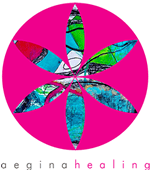Agios Nektarios | monastery & church
Miracle healer
One of the most visited sites on Aegina is the church of Agios Nektarios (Saint Nectarios) and the monastery of Agia Triada (The Holy Trinity) that is located on a higher level overlooking the church. Agios Nektarios of Aegina (1846-1920), is one of the most widely known Greek Orthodox Saints. He was officially recognized as a saint by the Ecumenical Patriarchate of Constantinople in 1961. Yearly, thousands of people from all over the world coming to Aegina to visit the tomb of Agios Nektarios for healing reasons, to pray to him or ask for his blessings.
Agios Nektarios was known as a great miracle worker, particularly as a healer of every sort of disease, he was also a prolific writer, theologist, philosopher, moralist, educator, poet, ascetic and mystic. Above all Agios Nektarios was a man of deep prayer, and a hard worker who laboured just as everyone else around him, no work was ever dishonorable to him.
He was despised by many who mistook his popularity amongst the people as an attempt to become patriarch. As such he was relegated.
In 1904 at the request of several nuns, he established a monastery for women on Aegina named The Holy Trinity, where he lived for the rest of his life as a monk. He wrote, published, preached, and heard confessions from those who came from near and far to seek out his spiritual insights. In 1920 he died at the age of 74.
Agios Nektarios Day
His memory is celebrated by many many people on the 9th of November, on the nameday of Nektarios. There are services in the church on the night before and there is a special procession in the morning, where the remains of Agios Nektarios are carried through the streets of Aegina town.
Visiting the church and monastery
Make sure your arms and legs are covered when you enter the buildings. Skirt are available at the entrance of the monastery and church. Entry free of charge.
You can visit the immense church that is still not totally finished. The mausoleum of Agios Nektarios is inside the church on the right side. After you visited the church you can climb the stairs to the monastery of the Holy Trinity, which I find the most interesting part of the complex. 14 Nuns are still living in the monastery. Recently, the monastery has been expanded with a huge guesthouse. The hill on which the monastery is built is named Xantos, from the word “xagnadema” (look out point), inviting you to survey the surrounding landscape. 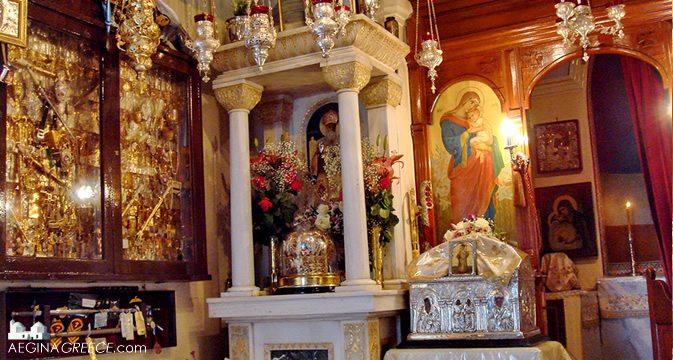 At the monastery area of The Holy Trinity you can visit 2 little chapels where you can see the old marble tomb where he was burried after he died. Many faithful can hear the Saint blessing them if they put their ear to the tomb and listen. In the left small chapel his remains are kept in a silver box. Behind the chapels you can visit the rooms where he used to live. Next to the chapels you can fill a bottle with holy Agios Nektarios water. There are also 2 shops where you can buy Agios Nektarios souvenirs, books, icons etc. Inside the shops you can ask for a small plastic bottle with oil and a small plastic bottle that you can fill with the holidy water. The oil and the bottles are free.
At the monastery area of The Holy Trinity you can visit 2 little chapels where you can see the old marble tomb where he was burried after he died. Many faithful can hear the Saint blessing them if they put their ear to the tomb and listen. In the left small chapel his remains are kept in a silver box. Behind the chapels you can visit the rooms where he used to live. Next to the chapels you can fill a bottle with holy Agios Nektarios water. There are also 2 shops where you can buy Agios Nektarios souvenirs, books, icons etc. Inside the shops you can ask for a small plastic bottle with oil and a small plastic bottle that you can fill with the holidy water. The oil and the bottles are free. 
How to reach “Agios Nektarios”
The church can be reached by:
- car – The area is called Kontos and is located 6 km from Aegina town or Aghia Marina. Take the inland road to Agia Marina, within 10 minutes you will see the big church on your left. The church and monastery are open daily.
- bus – The bus that is going from Aegina town to Agia Marina is passing Agios Nektarios. The bus stop is in front of the church. Click here for the bus timetables.
- taxi – You can also take a taxi when you arrive at the port. Click here for the indicative taxi prices.
Facts about Agios Nektarios
- 1846 – Agios Nektarios was born on October 1, 1846 in Silivria in the region of Thraki (Thrace – Northern Greece) to a poor family. His given name was Anastasios Kefalas. He was the fifth of six children. At the age of 14 he moved to Constantinople (Istanbul) in order to go to work and further his education.
- 1866 – He moved to the island of Chios, where he taught at a school for seven years.
- 1876 – Agios Nektarios became a monk at the age of 30, which is highly unusual in itself.
- 1879 – Three years after becoming a monk he was ordained a Deacon, taking the name Nektarios.
- 1885 – He graduated at the University of Athens in 1885. During his years as a student at the University of Athens, he wrote many books, pamphlets, and Bible commentaries. Following his graduation he went to Alexandria, Egypt, where he was ordained a Priest and served the Church in Cairo with great distinction.
- 1889 – In recognition of his piety and brilliance as a preacher, as well as his administrative ability, he was consecrated Bishop/ Metropolitan of Pentapolis by Patriarch Sophronios. He served as a Bishop in Cairo for one year, and was unjustly removed from his post by jealous clerics who envied his popularity with the people. Lies were made up about him by the jealous clergy. Patriarch Sophronios refused to listen to Agios Nektarios. He was sent away from Egypt without a trial or explanation, and was never given an opportunity to defend himself.
- 1891 – After his dismissal, he returned to Greece in 1891, where he sought employment as a preacher. He was appointed preacher in the jurisdiction of Evia, a large peninsula, north of Athens, where he served for two and a half years.
- 1893 – He was transferred to a part of the Greek mainland, west of Athens. He served as preacher there with the same great effectiveness as he had in Evia.
- 1894 – He was appointed director of Rizarios Ecclesiastical School in Athens where his service was exemplary for fifteen years. He developed many courses of study, and wrote numerous books, all while preaching widely throughout Athens.
- 1904 – At the request of several nuns, he established a monastery for women on the island of Aegina. The Monastery was named Holy Trinity and was finished in 1910. He also founded several churches and chapels on the island as well.
- 1908 – In December of 1908, at the age of 62, Agios Nektarios resigned as Director of the Theological school and withdrew to the Holy Trinity Monastery on Aegina, where he lived the rest of his life as a monk. He wrote, published, preached, and heard confessions from those who came from near and far to seek out his spiritual insights. While at the monastery, he tended the gardens, carried stones, and helped with the construction of the Monastery buildings that were built with his own funds.
- 1920 – Agios Nekatrios died on the evening of 8 November, 1920, at the age of 74. His body was taken to the Holy Trinity Monastery, where he was buried by a Priest Monk named Savas, who later painted the first icon of Agios Nektarios. His funeral was attended by multitudes of people from all parts of Greece and Egypt. By many people he was regarded as a Saint during his lifetime because of his purity of life, virtues, the nature of his publications, as well as the miracles he performed. Agios Nektarios also had a unique gift of foreknowledge.
- 1953 – His relics were removed from the grave on 2 September, 1953. His relics gave out a beautiful fragrance.
- 1961 – Official recognition of Nektarios as a Saint, by the Ecumenical Patriarchate of Constantinople, took place on 20 April, 1961.
- 1998 – Decision of the Church of Alexandria, 15th September 1998
“We hereby restore the ecclesiastical order of the Saint of our Century, Agios Nektarios, and grant to him all due credits and honours. We beseech Agios Nektarios to forgive both us, unworthy as we are, and our predecessors, our brothers of the Throne of Alexandria, for opposition to the Saint and for all which, due to human weakness or error, our Holy Father, Bishop of Pentapolis, Agios Nektarios, suffered.” PETROS VII
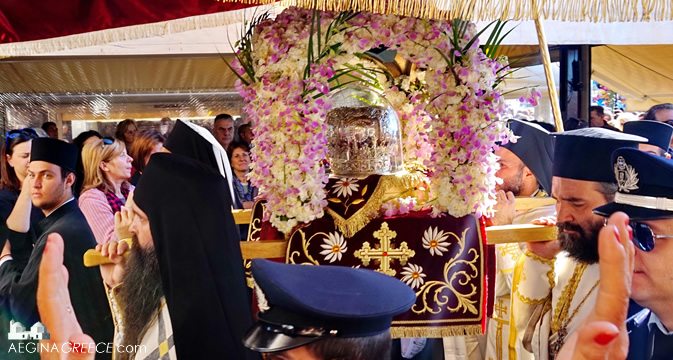
The first miracle attributed to Agios Nektarios:
During the last days of his life, Agios Nektarios was in the room for the incurables of the hospital, among many poor patients who were at the point of death. Beside the bed of Agios Nektarios was a patient that had been paralyzed for years. As soon as Nektarios gave up his spirit, a nurse of the hospital, together with a nun who had accompanied him, began to prepare the holy body for transportation to Aegina for burial. They removed an old sweater from him and placed it for convenience on the bed of the paralytic and continued to prepare the body. Suddenly, the paralytic patient became well and rose from his bed, praising the Lord. This was the first miracle after the repose of Agios Nektarios.
There have been more than two thousand miracles attributed to the intervention of Agios Nektarios. 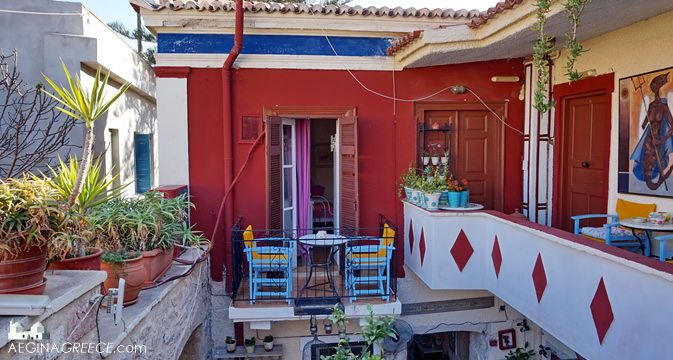 The room with the small balcony is the room where Agios (Saint) Nektarios used to stay when he still was an unknown monk, living in his monastery on the outskirts of Aegina. The Saint used to travel to Aegina town with his donkey for his food supplies and during the night he slept at the Aeginitiko Archontiko Hotel.
The room with the small balcony is the room where Agios (Saint) Nektarios used to stay when he still was an unknown monk, living in his monastery on the outskirts of Aegina. The Saint used to travel to Aegina town with his donkey for his food supplies and during the night he slept at the Aeginitiko Archontiko Hotel. 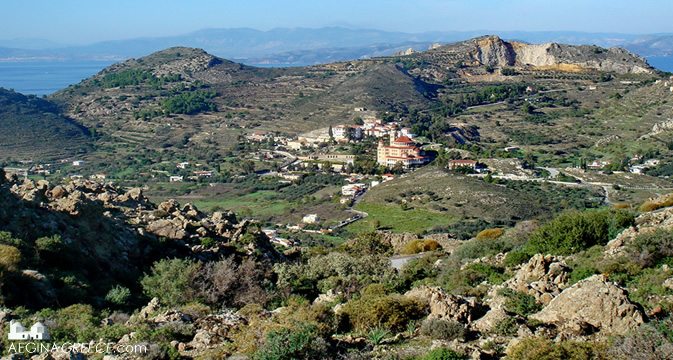
Interview with one of the sisters living in the monastery
text by Souzana Raphael
A massive, recently-built church sits up on a hill in the inland area known as Kontos on Aegina island, just a few miles from the port. Built for the most recent Greek Orthodox saint – Agios Nektarios – it is visited by large numbers of people every year, many of them seeking help from this miracle-working saint, who died in 1920. Near the church is a complex of buildings which include chapels, a store selling icons, holy oil, candles, postcards and the like, the old house in which the holy man lived, and the monastery inhabited by a small community of nuns who tend to the spiritual needs of those who come to seek solace and healing.
Daily routine
I spoke with one of the “sisters”, who greeted me with such sweetness and answered my questions so graciously, that I was sure that those coming to unburden themselves must find in her much comfort. I asked her about the daily routine of the sisters, and learned that they rise at 4:00 – 4:30 in the morning, attend church services between 5:00 – 8:30, and that the doors to the church open at 5:30 am. At 8:30 they eat a small breakfast and then go about their various chores – called diakonima – works in the service of God), in kitchen, office, guest-house, vegetable garden, with the chickens and their two goats, whose milk they drink, speaking with/listening to those who come in pilgrimage to the church to seek help.
They eat their midday meal at 13:00, during which time they listen to readings of the words of “the fathers” (of saints and holy men of the church). During the mid-afternoon hours (mesimeri), they may rest if needed and if time allows, though always they must dedicate time to praying for those who have asked for help during the course of the day. The sister with whom I spoke stressed that there is much work to be done in the monastery, with some employed helpers to assist the nuns. During summer there is an ‘esperino’ service at 18:30-19:30 (esperino being the evening star). The evening meal is at 20:30, and the gates to the church also close at that time for the night.
I asked if the sisters who come to live and work in the monastery come there for life, and she seemed surprised by my question. “If you love God, there is no end,” she told me. New sisters are accepted, both young and old. “And how are your economic needs supported?” I asked her. She told me that the books, candles and icons sold in the little church store are their main means of support. “Donors have given the church money for large works,” she added, “and visitors sometimes bring us gifts of food. Once, a coach from Macedonia came and unloaded many crates of cherries for us!” 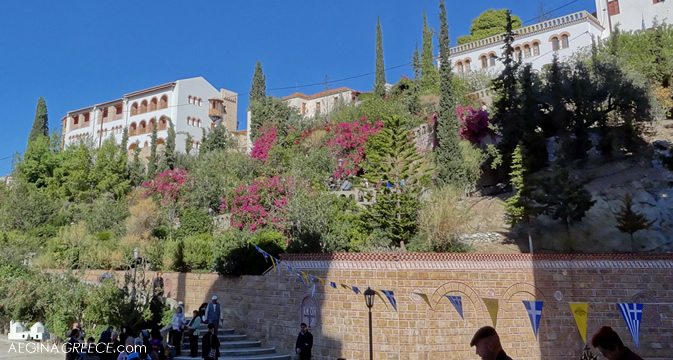
Lodging at the monastery
“Does the monastery provide lodging for guests?” I asked. “Only for one night, or sometimes for two for those who have come a long distance.” The procedure for requesting lodging is via FAX, the number: (+30) 22970 53998. One must state the number of guests seeking lodging and give a return FAX number. “We don’t accept money. We are a hospital of the soul,” I was told. “People come here to have us hear their pain.”
Find your accommodation on Aegina island
[booking_product_helper shortname=”agios nektarios”]
Leousio Foundation
The church of Agios Nektarios supports her foundation known as Leousio Foundation “Agios Nekatrios” which provides daily meals to those in need (many of them elderly or disabled people), numbering 55 households, to whom the food is delivered from the “sisitio” kitchen. (I might add here that many local citizens provide the volunteer labour for preparation and delivery of these meals, with many ingredients donated by the local supermarket chain, Kritikos. There are also events held as benefits to support this admirable effort.)
Hospital Agios Dionisios
I learned too that the church built the local hospital (of Agios Dionysios), and plans to turn the building where meals are prepared into a “gerokomio” (old people’s home). Trained sisters have served for periods of time as nurses in the hospital, and also as teachers for local children. A seaside campsite supervised by the church is located in the area called Tourlos, near Vagia. The church has restored also an old building in Aegina, which is a children’s center, for music lessons, games, and other activities. “But the church doesn’t involve itself in politics,” the sister added.
Icons, oil etc
Those who wish to have icons and other items mailed to them from the church store can request such items via FAX and should include their address in the request. Holy oil & water is free, though books and other items require payment.
Contact information
address: 18010 Kontos, Aegina island
Telephone: +30 22970 53806 (mother superior)
Telephone: +30 22970 53800 (office)
Telephone: +30 22970 53821 (guesthouse)
Fax: +30 22970 53998
Unfortunately they are not working with email.

